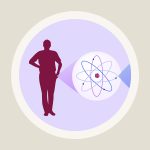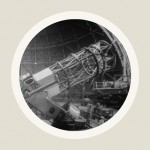Mass and more
An account of which physical properties act as sources of gravity – includes consequences for collapsing stars and for cosmology
An article by Markus Pössel
There are a number of fundamental differences between Einstein’s theory of gravity (general relativity) and the classical Newtonian description. Arguably the greatest difference is the role of geometry: In Einstein’s theory, gravity is not a force; instead, it is inextricably linked with distortions of the geometry of space and time. But there is at least one further difference, and that is related to the sources of gravitational effects.
Mass
In Newtonian gravity, a single property governs the gravitational actions of an object: the object’s mass. The strength of the gravitational force with which a body acts on other bodies, and those bodies on him, is directly proportional to the body’s mass. Mass plays the same role for gravity that an object’s electric charge plays for the electrostatic force – in short, mass is “gravitational charge”.
Energy
In Einstein’s theory, there is a greater variety of gravitational sources. The first generalization follows directly from Einstein’s famous formula describing the equivalence of mass and energy, E = mc2. This formula was originally derived in the context of special relativity and refers to mass as a measure of a body’s inertia – the body’s resistance to any attempts to change its velocity. However, it holds true in general relativity as well: all kinds of energy contribute equally to an object’s gravity – not only the mass of the body’s constituent elementary particles, but also, to give some examples, its thermal energy and the energy of any electromagnetic radiation trapped inside that body.
Pressure
But that is not all. Besides the mass (equivalently, the energy, or more precisely mass and energy density), Einstein’s equations contain a further source of gravity: the inner pressure of matter.
In most situations, the contribution of pressure to gravity is undetectably small and can be neglected. This is true, for instance, throughout the solar system. But in more extreme situations the pressure contribution can be crucial. One example is the case of a very massive star. Stars keep a precarious balance between gravity – with a consequent tendency to contract to ever-smaller volume – and an inner pressure resisting any reduction of volume.
For stars like our sun, the inner pressure results from the thermal motion of the particles of the stellar gas; this motion, in turn, is kept going by nuclear fusion processes heating up the star’s interior. The more compact a star, the greater the pressure that is needed to prevent further collapse. But once a certain degree of compactness is reached, the inner pressure needed to counterbalance gravity would be so great that its own contribution to gravity becomes significant – instead of preventing the collapse, the gravitational influence of such pressure would accelerate it! This leads to an upper limit of compactness, above which no stable configurations of matter are possible – an object reaching that degree of compactness would keep collapsing until a black hole is formed.
Another context in which the pressure contribution is important arises in modern cosmology. According to astronomical observations, our universe has entered a phase of accelerated expansion. In the cosmological models, this acceleration can be traced back to an additional term added to Einstein’s equations, the so-called cosmological constant. Exactly equivalent to this cosmological constant would be an unusual type of energy permeating all of space, which is called dark-energy. Quite generally in our universe, masses are always positive, so gravity is always attractive. However, by definition the pressure associated with dark energy is negative and comparatively strong. Pressure is a source of gravity, and the gravitational effect of this negative pressure does not lead to attraction, but to repulsion – this pressure-induced gravitational repulsion is how dark energy causes the accelerated expansion of the universe.
Further Information
For the basics of Einstein’s theory of gravity, please refer to the chapter General relativity of Elementary Einstein.
Related spotlights on relativity can be found in the category General relativity.
Colophon
is the managing scientist at Haus der Astronomie, the Center for Astronomy Education and Outreach in Heidelberg, and senior outreach scientist at the Max Planck Institute for Astronomy. He initiated Einstein Online.
Citation
Cite this article as:
Markus Pössel, “Mass and more” in: Einstein Online Band 01 (2005), 01-1011










